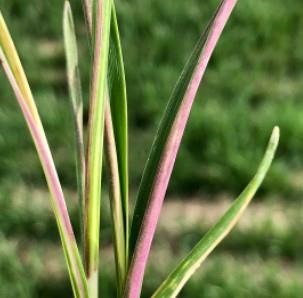We often generally refer to aphids collectively in wheat as “cereal aphids”. For aphids such as English grain aphid, bird cherry-oat aphid and corn leaf aphid, virus transmission is generally the biggest concern. Winter wheat can be at high risk to viruses (such as barley yellow dwarf) when aphids move to wheat after planting in the fall. This risk can be especially high for early-planted fields. That is, early-planted winter wheat can receive aphids from over-summering hosts that may also harbor wheat viruses.
Viruses can be transmitted in the spring; however, it is thought that older plants have greater tolerance to virus infection.
Russian Wheat Aphids Can Cause Direct Damage to Wheat
A couple cereal aphids — such as Russian wheat aphids and greenbug — more commonly cause direct damage by their sap-sucking activities alone and their numbers can build up rapidly to cause significant economic damage to wheat. For example, Russian wheat aphid can live for 60-80 days and produce up to 80 offspring when the ambient temperature is 68°F. Furthermore, an individual Russian wheat aphid is reproductively mature in about eight days. That should give you a sense of just how rapidly a Russian wheat aphid population can grow.
Impact on yield from these aphids range about 0.5% for every 1% of infested tillers from tillering through flowering. Additionally, these yield impacts may be exacerbated by dry conditions.
Symptoms of infected tillers are very conspicuous (Figure 2). As the aphid colony develops and the aphids feed, leaf edges will roll and enclose the aphid colony in a protected, tubular leaf. Once a colony is enveloped within this protective structure, natural enemies and insecticides cannot reach it.
Additionally, infestations that develop on and roll flag leaves can trap the awns of the emerging wheat head, resulting in poor pollination. These curled heads can look very similar to 2, 4-D injury.

The Situation in Nebraska
In western Nebraska, we started finding Russian wheat aphids in April again this year. Aphid numbers at present do not appear to be high enough in western Nebraska to warrant treatment. However, cooler temperatures do extend the longevity of these aphids, so conditions may be adequate for populations to slowly build and then break out once the temperatures warm. Keep a close eye on your wheat fields now and into June for the development of aphid populations.
Scouting for Russian Wheat Aphids
Spring thresholds for Russian wheat aphids have been found to vary based on plant stage (Table 1), but generally range from 5-20% infested tillers. However, for fields in which a marginal yield is expected (below 40 bushels/acre), you might consider a higher threshold as a larger amount of damage would be needed to justify treatment costs.
To sample, select 20 sample areas of a field at random and closely inspect five tillers at each of these sites for aphids. Use a total of at least 100 tillers per field (five tillers per sample area) to estimate the infestation within a field. Tillers showing the characteristic symptoms of this aphid make identification of infestation quite easy. See, NebGuide G1284, “Cereal Aphids” for guide on cereal aphid identification.
Table 1. Nominal Russian wheat aphid thresholds for springtime winter wheat sampling.| Thresholds for Russian Wheat Aphids in the Spring for Winter Wheat |
|---|
| Crop Stage | Treatment Threshold |
|---|
| Regrowth to Early Boot | 5% - 10% damaged and infested tillers |
| Early Boot to Flowering | 10% - 20% damaged and infested tillers |
| After Flowering | More than 20% damaged and infested tillers |
Controlling Russian Wheat Aphids
Consideration of the natural enemy population is important as improper timing or use of some chemicals can reduce natural enemy numbers disproportionately to the pest and set back biological control activity. I won’t go into details here; however, there are several parasitoids and predators that will attack and keep aphid populations regulated in our wheat fields. They offer the most cost-effective management action, so careful consideration of the above threshold is warranted.
Lastly, there are a handful of insecticides available in wheat that are useful in managing Russian wheat aphid (Table 2). However, because these aphid populations tend to establish on field edges first, if detected early enough, border applications of insecticide in wheat can be sufficient to reduce Russian wheat aphids to a level that is below economic importance. Such treatment strategies may provide conservation of biological control and suppression of an aphid outbreak while saving on input costs.
Table 2. Selection of insecticides labeled for use in wheat with efficacy against Russian wheat aphid*.| Chemical | Group | Formulations | Rate | PHI (days) | REI (hours) | Notes |
|---|
| Beta-cyfluthrin | 3A | Baythroid XL | 0.014 to 0.019 lb ai/A | 30 (3 days for grazing or foraging) | 12 | Retreatment interval 3 days. Do not exceed 0.038 lb ai/A per season. |
|---|
| Cyfluthrin | 3A | Tombstone | 0.028 to 0.038 lb ai/A | 30 (3 days for grazing or foraging) | 12 | Retreatment interval 3 days. Do not exceed 0.076 lb ai/A per season of cyfluthrin alone, or the combined total of cyfluthrin plus beta-cyfluthrin. |
|---|
| Lambda-cyhalothrin | 3A | Silencer, Warrior II with Zeon Technology, many generics | 0.02 to 0.03 lb ai/A | 30 (7 days for grazing or foraging) | 24 | Do not exceed 0.06 lb ai/A per season |
|---|
| Lambda-cyhalothrin/chlorantraniliprole | 3A/2B | Besiege | 0.059 to 0.098 lb ai/A | 30 (7 days for grazing or foraging) | 24 | Retreatment interval 7 days. Do not exceed 0.06 lb ai lambda-cyhalothrin or 0.2 lb ai chlorantraniliprole per year. Make no more than 4 applications per acre per crop. |
|---|
*Best control is obtained if treatment applied before leaf rolling symptoms.
Source : unl.edu